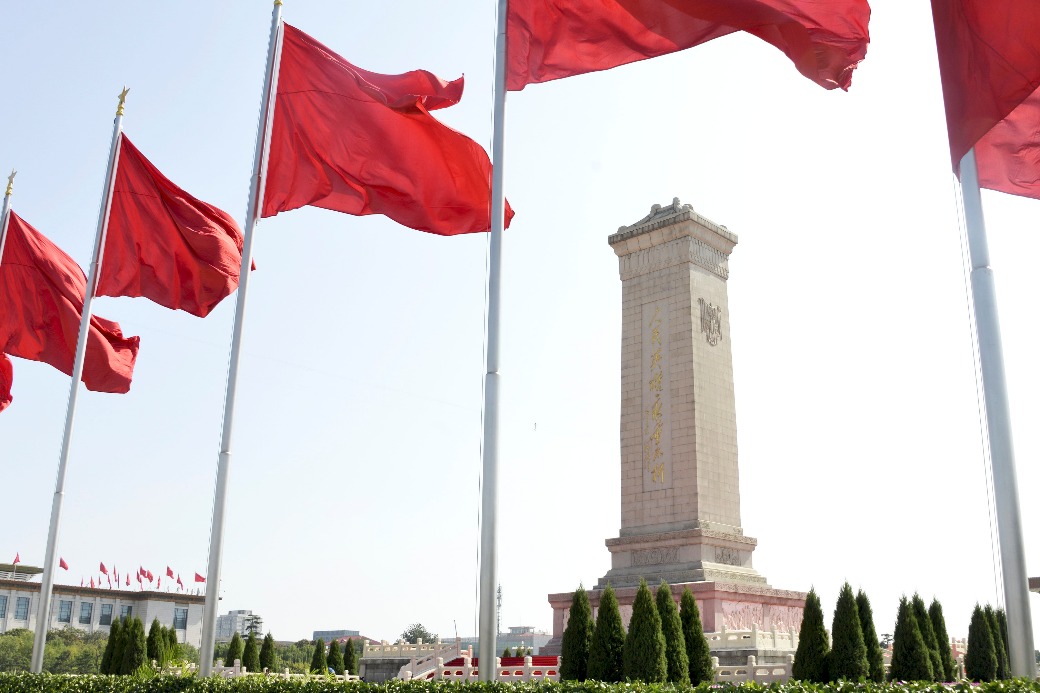Catalyst for restructuring


A balanced, equitable and sustainable growth model will help China better withstand the US trade war
Since the first Donald Trump administration, the United States has waged a trade war against China, and it has started to target almost all of its trading partners in his second term, citing the needs to reduce the trade deficit, reshore manufacturing industry and improve employment. However, the justifications have proven unfounded and untenable.
The US Department of Commerce data showed the US trade deficit in goods and services actually increased from $566 billion in 2017 to $918.4 billion in 2024. The manufacturing industry employment stood at 12.98 million people in 2022, but the figure has now declined to 12.8 million. Furthermore sweeping tariff hikes have disrupted the global supply chains and caused greater uncertainties to the world economy.
Tariff hikes and the trade war are part of a broader deglobalization movement, which helped President Trump win elections in 2016 and 2024, and his wins also showed that his protectionist agenda is not short-lived. As long as the globalization dividends are not fairly distributed, political tools such as a trade war will continue to be used by populist politicians to externalize the internal tensions in their countries.
Over the past few decades, US investors, multinational corporations, and high-income groups have reaped enormous benefits from globalization, while the gains for the low-income groups and the middle class were minimal. For example, the income of the US middle class grew by merely 0.5 percent from 1990 to 2023, while the US economy maintained a 2 to 2.5 percent annualized growth during that period. The widening wealth gap has fueled political polarization in the US and provided fertile soil for the rise of deglobalization sentiment.
The US trade war and broader US-China tensions were inevitable. Apart from the unfair distribution of globalization dividends mentioned above, the rise of emerging economies poses serious challenges to the existing hegemonies. In particular, the US has developed strong strategic anxiety at China's emergence as a leading economic power and a technological rival.
The US perceives China as strategic challenger, irrespective of whether the Republican or the Democratic party is in power. The bipartisan goal is to slow or even stop China's growth, and this structural rivalry is likely to persist for decades to come.
The US-China trade war has now reached a stalemate. While high-level interactions and economic dialogues continue, the US government is signaling a tough stance. Recently, the US treasury secretary threatened that the US will impose a trade embargo if China does not concede to the demands of the US. Meanwhile, the US has tightened export controls, including halting supplies of key parts for the C919 aircraft, restricting sales of chip design software, and even threatening to revoke a significant number of Chinese students' visas. The risks of decoupling and supply chain disruptions are lurking over the global economy.
For China, the impacts from the trade war, decoupling and supply chain disruption may be felt in two ways. On the supply side, they create obstacles to imports of high-tech equipment and capital goods, posing challenges to industrial upgrading. On the demand side, they exert pressure on China's exports of consumer goods.
To alleviate the impacts, China should continue to increase its R&D investment and improve the innovation system. Meanwhile, every effort must be made to boost domestic demand.
The first and foremost task is to further develop the system for internal inventions and innovations, optimize the allocation of R&D resources, improve research and development efficiency, and facilitate commercialization and application of R&D outputs through market and institutional reforms.
China's R&D expenditure exceeded 3.07 trillion yuan ($426 billion) in 2022. It increased by 8.4 percent to 3.34 trillion yuan in 2023 and a further rise of 8.3 percent to 3.61 trillion yuan in 2024. It has proven that any attempts to contain China's technological advance will fail, and instead, have further spurred China's innovation awareness and vitality.
At the same time, it is crucial to boost domestic demand. China's producer price index has remained in the negative territory in recent years, falling by 3.0 percent in 2023 and another 2.2 percent in 2024. The consumer price index also dropped from 2.9 percent in 2019 to just 0.2 percent in 2024, showing signs of deflation.
The root cause for falling prices lies in the persistently low household consumption which accounts for only one-third of GDP, far below the international norm.
To address this problem, China should gradually lower the ratio of investment in GDP from over 40 percent to 25-30 percent, aiming for a structural shift from investment to consumption. This can be achieved by reducing support for industries facing overcapacity and cutting inefficient government investments. Lower investment demand will help bring down interest rates, further driving the savings rate downward.
Second, concrete measures must be taken to raise the share of household income in GDP from below 50 percent to at least 60 percent. One of the ways to do so is through tax reforms, e.g., introducing a more equitable goods and services tax, raising the threshold of personal income tax and lowering personal income tax rates. In addition, government transfer payments must be significantly expanded to channel more public revenue, including State-owned enterprise profits, toward low-income groups through targeted consumption subsidies and direct cash transfers.
Third, improving the social security system will help reduce people's concerns about future risks and is essential to enhance consumer confidence and capacity. China's social security expenditure as a percentage of GDP is significantly lower than that of the Organization for Economic Cooperation and Development countries. It is recommended to increase this share by 3 to 5 percentage points, focusing on narrowing the urban-rural gap in the levels of social protections, particularly in the aged pensions.
Finally, improving income distribution among individual and households is critical to expand consumption. By ensuring the low-income groups to grow their incomes faster than their wealthier counterparts, the overall marginal propensity to consume can be increased, thereby lifting domestic consumption and reducing the demand-supply imbalance.
The US-China trade war is an epitome of the challenges arising from the broader reshaping of globalization. Yet, it also serves as a catalyst for China to accelerate its economic restructuring. The key to addressing these challenges lies in building a more balanced, equitable, and sustainable model of economic growth.
The author is a chair professor at Nankai University and a former senior official at the United Nations and the Asian Development Bank. The author contributed this article to China Watch, a think tank powered by China Daily.
Contact the editor at editor@chinawatch.cn.


































